Review and photographs by Lanthanotus, edited by Suspsy
Here comes a review I’m really excited about! Well, not about the review itself, but the models. When I first encountered REBOR while reading the Dinosaur Toy Forum, I was thrilled by the level of detail and the paint jobs on their models, but being not too keen about toothy theropods, I did not decide to buy any of them. However, when REBOR released the first pictures of their Dimorphodon in the summer of 2015, I set it on my list of must haves. Having grown up with the vivid but also somewhat apocalyptic paleoart of Zdeněk Burian, I found myself thrown back in time when this pterosaur was a nightmarish flying ghoul. Granted, REBOR did a great job in creating a modern restoration of the Dimorphodon, but in some major parts it nevertheless resembles the “death from above” creature I used to love.
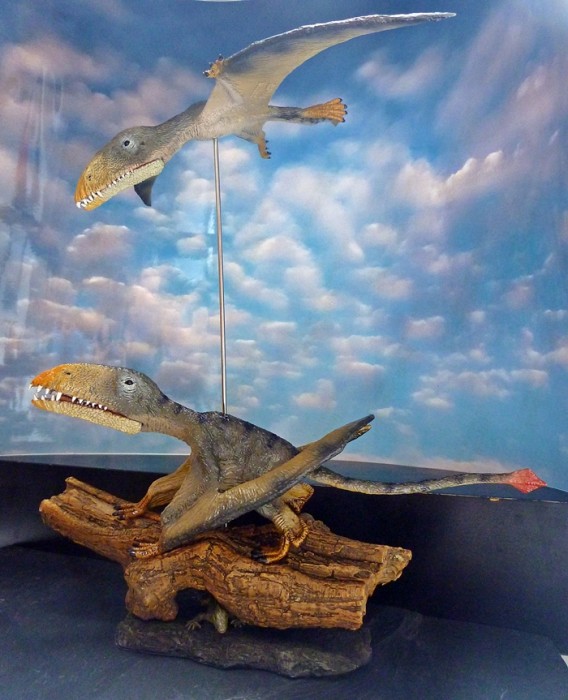
REBOR probably did not select Dimorphodon by chance. According to Mark P. Witton, the species is “something of a pterosaurian A-lister,” being the first pterosaur identified from Britain and the first outside of Solnhofen (if you like to read anything up to date and ressourceful about pterosaurs, go get Witton’s book). The first Dimorphodon fossil was collected by Mary Anning (whose name you all probably know from her discovery of gigantic marine reptiles as Ichthyosaurus and Plesiosaurus) and classified by William Buckland as Pterosaurus macronyx. A more complete fossil was later classified as Dimorphodon macronyx by Richard Owen.
Now, what’s in the box for this review….

The Dimorphodon macronyx comes as a two-part diorama and both parts can be bought separately for around 35 to 40 dollars/euros each. Buying both as a set usually comes with a discount of around 10 units of the currency in question. As with all REBOR models, these have names as well, the male being named Punch and the female Judy. These names are inspired by some popular hand puppets in the UK (luckily REBOR is British; if they were a German company, the pterosaurs would probably be named “Kasperl” und “Gretel”). Also like all other REBOR models, these come in shiny mat black cardboard boxes with black and white prints of the animal’s skeleton and external body line. Somewhat fortunately, I’m no box collector as otherwise the slight “misprint” on Punch’s box would bother me (come find me).
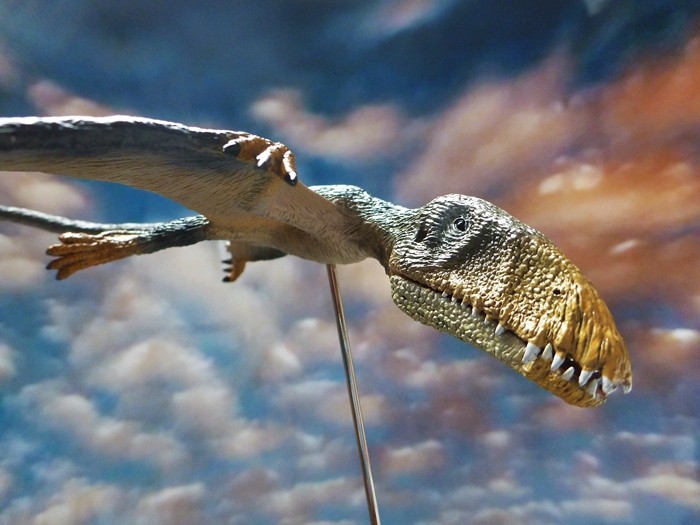
The models come tightly packed in molded plastic and their snouts are tied for maximum protection from mechanical force. Punch and Judy being my first REBORs, I was under the impression that they would be made from some kind of resin. While their bases are indeed made from some heavy and hard resin, the Dimorphodons themselves are not. They are made from a similar or even same kind of plastic as Schleich’s and other major toy companies’ models. Given the delicate nature of a pterosaur’s body, I rate this a good decision as the models can withstand some harsh handling and could even serve as a child’s toy, although the articulated jaws may not be as robust as those of Papo’s or Schleich’s (I did not test this to the extreme though). Both models come with a detailed information sheet about Dimorphodon‘s paleo-history.
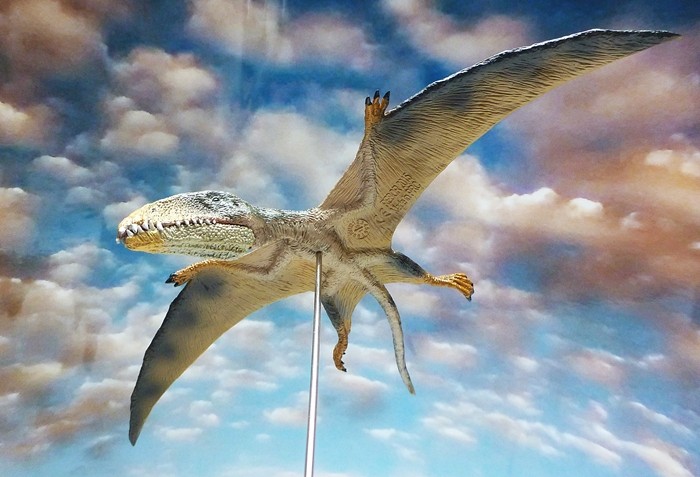
So . . . ladies first: Judy is depicted in full flight with the arms spread wide to a wingspan of more than 24 cm. The wing membranes are thin, tightly stretched, and exhibit fine skin folds that are going into different directions on the various patagiums depending on their main orientation of stretching. Judy’s body is covered in pycnofibres on the upper side, while the belly and underside are mostly bare skin. Her head is slightly turned down and to the right as if looking out for Punch, prey, or a spot to land on. The lower jaw and the middle part of the upper skull is decked with round scales. The tip of the snout seems to be lacking fur or scales, but boasts a texture that resembles some scarred beak. The articulated jaws show the two types of teeth the animal derived its name from, with large, interlocking teeth in the anterior jaw and small, peg-like teeth in the posterior part of the jaw. When the mouth is opened, it unveils a pink fleshy tongue and a detailed, ribbed gum. Judy is colored on the upper body in mousy gray with dark grey stripes and ochre areas on her membranes and underside. Her hands and feet are brownish yellow and the tip of her snout is pale orange. Judy’s base is grayish-black with some tarnished green. There are holes to fit in the metal rod for her support as well as the snug spots to place Punch’s base. A small, lizard-like reptile of unknown species and drab green coloration serves as a possible prey or wedding present for the pair.
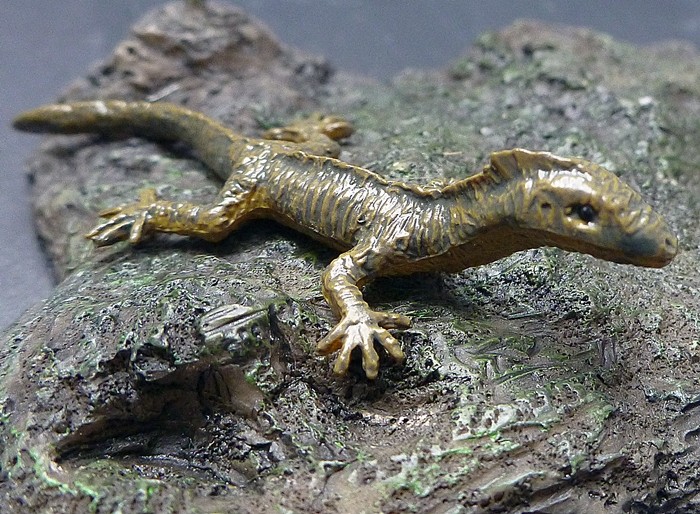
Punch is shown in a grounded, quadrupedal position. Unlike other REBOR models, he lacks the spots on his base where he snuggles in perfectly. While some of his claws and at least one foot may not grasp his base too well, he not only still looks good while being placed on his log, but can also stand perfectly well on an even surface, so you can place him on any location on your desk or your wife’s dresser. Punch is distinguished from Judy by a slightly bigger head and more vivid colours: orange at the top of his snout, black stripes on his back, dark brown-yellow hands and feet, and dark red for the tip of his tail. In addition, he lacks the stripes on his arms and legs. While some more advanced pterosaurs species showed strong sexual dimorphism, with great differences in total body size or ornamental crests and possible coloration, such is not evidenced for Dimorphodon and some other early pterosaurs. Even groups of animals famous for their extreme sexual dimorphism, such as birds, include many species with no obvious sexual dimorphism at all (think of sparrows, ravens, parrots and many other common and uncommon birds). So it’s totally legit that the differences shown in Punch and Judy are not too strong. Personally, I like their comparably drab color scheme.
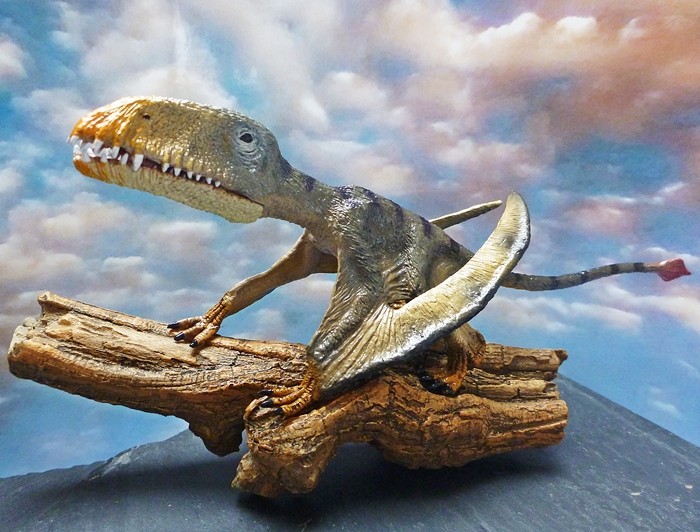
Punch’s base is a tree log of very fine detail. In fact, the details are so elaborate (expect for the lower end of the log)that I suppose REBOR used a real log or branch and 3D scanned it as a model for that base.
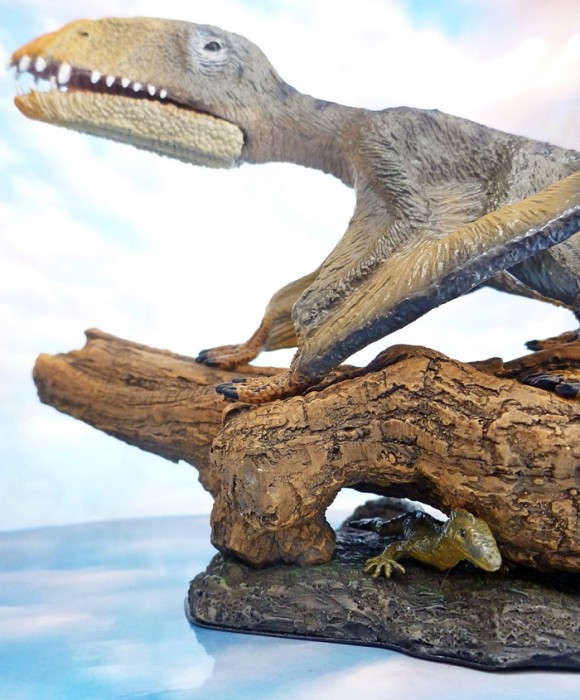
So far, we’ve skipped well around the scientific accuracy, so here we go. Let’s begin with the inaccuracies, of which there are a number, though they may not be that obvious. Dimorphodon‘s physiology is fairly well-known from several great fossils, so we know that the animal possessed toes and fingers of significantly different length with narrow, strongly hooked claws—an adaption of most climbers. Both features are lacked on Punch and Judy and the claws look more like pointy cones than the real thing. This is an unfortunate flaw. Another inaccuracy may be the extent of the brachiopatagium. As Dimorphodon is deemed to be an infrequent and more generalized flyer than more advanced pterosaurs, its main flight membrane is thought to be very broad and extending to the ankles. This is reasoned speculation though, and not evidenced by fossil finds as of yet. Another possible inaccuracy is the absence of binocular vision. Punch’s and Judy’s eyes are set back quite a bit into the skull and are unable to view over the bony strut that separates the orbit from the antorbital fenestra. While this allowed the sculptor to depict the Dimorphodon‘s skull with its distinct skeletal structures, it’s highly unlikely that these structures were visible on the living animal. Also, while monocular vision is not entirely impossible for a flying animal living in a three dimensional environment, it’s unlikely that a predatory animal developed specialized body features for flying, but not binocular vision.

After this summary of inaccuracies, let’s now look at the scientifically correct features and fine details. The propatagium is supported by the pteroid, a small specialized bone that looks like a reverted first digit (which it is not). Accordingly, the uropatagium is supported by the fifth toe, which is finely sculpted in both animals. The fourth finger which spans the brachiopatagium exhibits its joints only in the slightest way, which is very nice, and while Judy’s flight membranes are wide spanned and thin, Punch’s are tightened and therefore wrinkled and comparably thicker. Both animals have cloacal openings that are slightly different in both sexes.

In my personal view, the overall proportions and vivid details of REBOR’s Dimorphodons make them first rate models despite the few scientific flaws. Also, the glossy color detracts a bit from their otherwise totally lively look, but for me, REBOR’s Dimorphodons, with their combination of modern reconstruction and historic charm are a must have.
Disclaimer: links to Ebay and Amazon on the DinoToyBlog are affiliate links, so we make a small commission if you use them. Thanks for supporting us!




The sparrows I’ve seen over here in the UK do have obvious sexual dimorphism…: http://www.rspb.org.uk/discoverandenjoynature/discoverandlearn/birdguide/name/h/housesparrow/index.aspx
There are two things I don’t find convincing about the integument of these Dimorphodon. The first is the underside being bare. Why would it be on such a small pterosaur? The second thing is the scales on the head. As far as I’m aware there’s no evidence pterosaurs had scales. Additionally, it looks weird and unnecessary having the head go from pycnofibery to scaly to bare. My guess is on a real Dimorphodon it would just go from pycnofibery to bare.
I prefer REBOR’s Dimorphodon to Wild Safari’s though, as I really don’t like the head of the latter (sorry Doug!).
I should clarify, I don’t like the Wild Safari Dimorphodon’s head because it’s all scaly. I would have preferred it to have been covered in pycnofibers up to the snout with the snout bare.
Thanks for your comments.
I missed one issue in this review as I wrote the text right when I got the figures, but only recognized the issue when Punch and Judy stood on my desk for more than a week: The wings slightly warp,…. on Judy I think it’s simply related to the weight of the wings themselves and the warping is weak, to same degree on both wings and looks quite natural. On Punch however, the warping caused the wing tips to touch each other and made some bones of the wing finger look like they are broken. The issue was solved with a short hot water bath and repositioning under cold water and since then his wings hold their position.
Great review, this is easily the best product thus far from Rebor.
Magnificent scientific review of Lanthanotus pterosaurs. Moreover lack review Rebor lizard belonging to the diorama. In all the rest I agree with Lanthanotus.